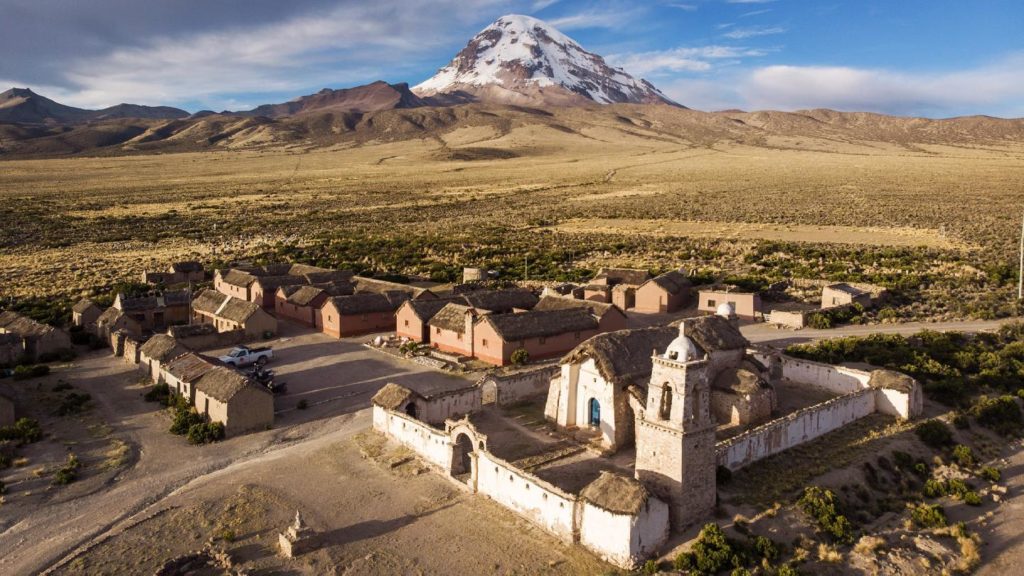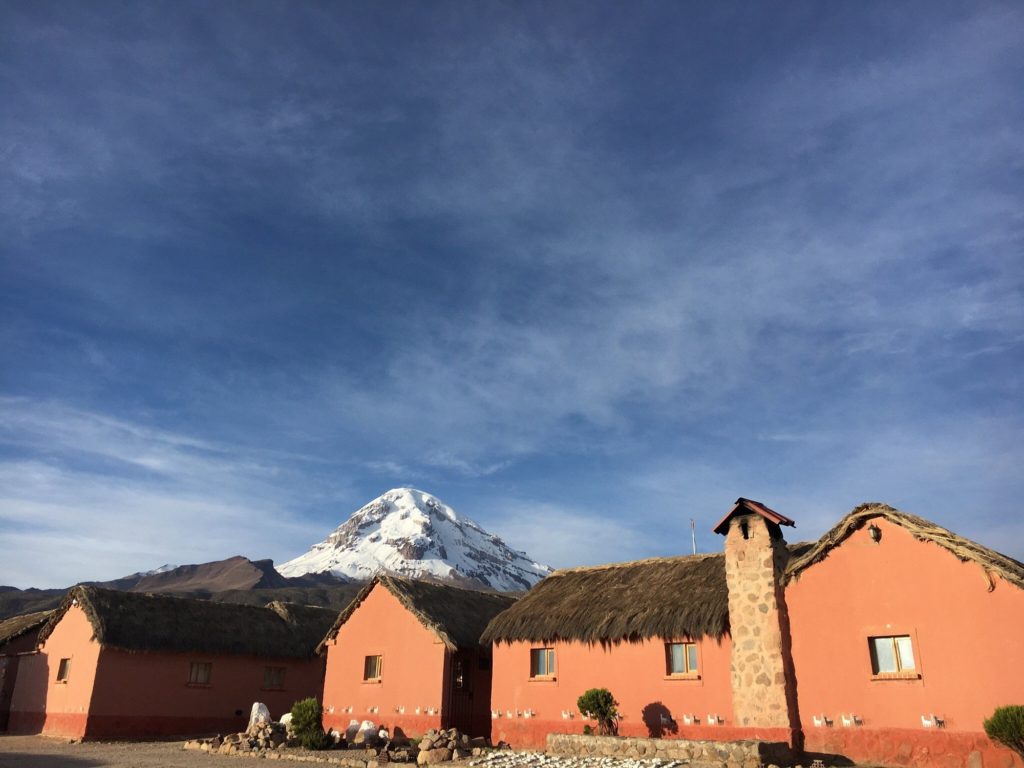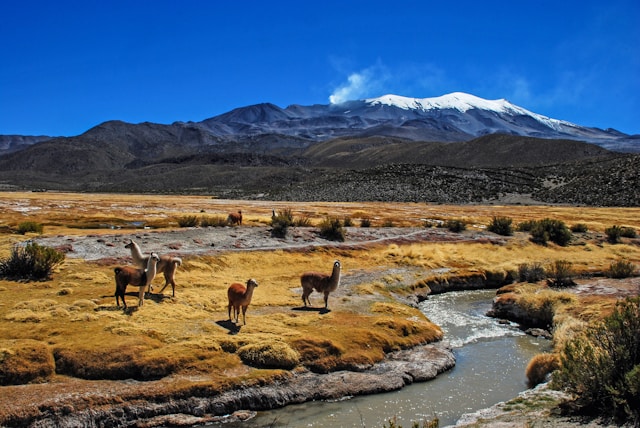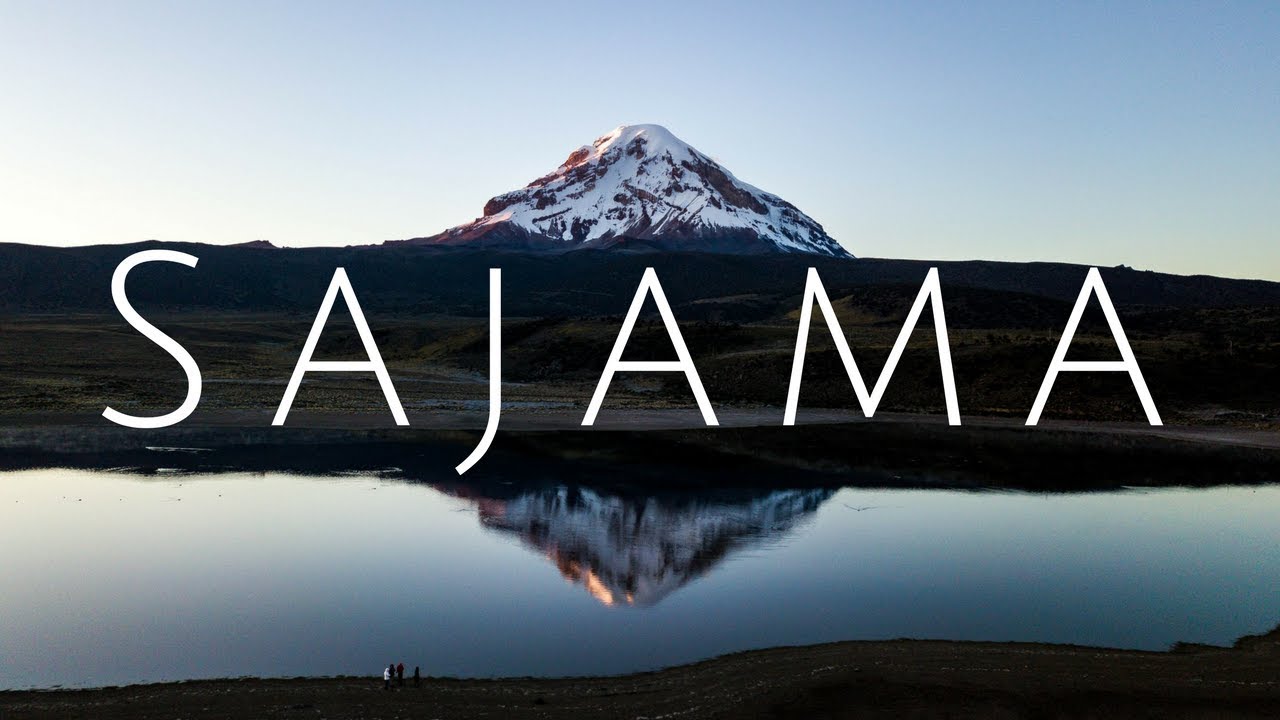By Katherine M for Pie Experiences
High on Bolivia’s western altiplano, the sky stretches beyond logic, the earth exhales sulfur and steam, and the silence is so vast it almost has a heartbeat.
This is Sajama National Park — a place not designed for tourists, but for pilgrims of stillness, seekers of places where nature speaks in other languages.
It’s not an easy place. The air is thin, the cold bites, and there’s a weight to the landscape that never quite leaves you. But that’s exactly the point. Sajama doesn’t seduce you — it tests you. And if you’re still, if you listen, it rewards you in whispers.
The Way In: Toward the Edge of the Andes
The journey from La Paz begins in the early hours, when the city still sleeps under its wool blankets of fog. The road west becomes flatter, emptier, more silent with every kilometer. Llamas appear like sentries at the horizon, and the mountains begin to rearrange themselves — sharper now, closer to the sun.
As we entered the boundaries of Sajama National Park, the wind shifted — drier, colder, charged with the scent of mineral dust and faded ichu grass. There are no signs announcing your arrival. Only the changing mood of the land.

Sajama: Not a Mountain, But a Presence
You don’t see Sajama at first — it appears.
One moment, the horizon is flat and endless; the next, this immense, snowcapped mass rises out of nowhere, solitary and self-contained, dominating the Bolivian sky.
At 6,542 meters (21,463 feet), Mount Sajama is the highest point in Bolivia — but height doesn’t define its importance. Spirit does.
To the Aymara communities that live at its feet — in villages like Tomarapi, Sajama, and Lagunas — this volcano is far more than a geological feature. It is an apu, a sacred mountain, a living being with moods, will, and memory.
They call it el doctorcito — “the little doctor.”
The nickname sounds endearing, even playful, until you understand its meaning.
For the people here, Sajama heals.
When illness strikes, when rain doesn’t come, or when the balance of life feels disturbed, locals make offerings to Sajama — coca leaves, alcohol, a splash of chicha, maybe a few drops of llama fat burned in the fire.
They whisper their petitions not to the sky, but toward the mountain. They believe Sajama listens. And sometimes, it answers.
“He’s a doctor for the soul and for the land,” said an old man I met near Tomarapi. “When the earth is sick, we ask him to bring back balance. When our animals die, or the water dries, we bring him gifts so he remembers us.”
To an outsider, this might sound like folklore — but in Sajama, the line between myth and medicine is thin.
The mountain controls weather, fertility, and fate. When its peak is hidden in cloud for too long, elders say it’s angry.
When snow melts early, they worry it’s tired.
When a long drought finally breaks, they smile and say: el doctorcito ya curó la tierra — the little doctor has healed the earth.
Standing beneath Sajama, you begin to understand.
It radiates something — an invisible gravity that isn’t physical but emotional. The air feels charged, as if the mountain is aware of you, measuring your intentions.
The silence isn’t emptiness; it’s communication.
It’s easy to forget that this volcano was once alive, spewing molten fire. The energy that built it still hums underfoot — felt in the thermal pools, the geysers, the trembling heat that seeps from underground.
To live here is to live in conversation with that power.
For the Aymara, the world isn’t divided between humans and nature — everything is connected, and everything has spirit. The rivers, the stones, even the winds that howl through the grasslands carry messages. But Sajama? Sajama is the elder, the guardian, the listener.
In the small village chapel near Tomarapi, you might see something surprising — a wooden cross wrapped in traditional awayos (woven Andean textiles), next to a small photo of the mountain.
Catholicism and ancient Aymara beliefs coexist here, layered, inseparable. Jesus heals the soul; Sajama heals everything else.
As the sun begins to set, the light bends around the volcano, and its icy crown glows gold, then pink, then violet.
No one speaks.
Even the wind seems to stop for a moment, out of respect.
And in that stillness, you understand why they call it the little doctor.
Not because it’s small — but because it knows the medicine that modern life forgets: silence, humility, and balance.
Best time to visit Uyuni Salt Flats
Where to stay in Uyuni and Colchani in Bolivia
Thermal Mornings and Geysers that Whisper in Sajama National Park
The first time I saw the hot springs in Sajama National Park, I was wrapped in four layers of wool and still shivering. It was just after 5:30 a.m., the moon still high, the sky still dark. A thin crust of frost covered the grass, and my breath came out in thick clouds. My body resisted stepping out of the 4×4.
And then I saw the steam — rising gently from the land like a breath exhaled after centuries of silence.
This, I was told, was one of the highest natural thermal baths in South America, and unquestionably one of the most surreal. Located at over 4,300 meters above sea level, these pools sit quietly on the open plain, surrounded by golden ichu grass, grazing vicuñas, and the ever-watchful silhouette of Mount Sajama in the distance.
I hesitated as I stripped off my layers. The air bit at my skin with ferocity. But the moment I stepped into the pool, the pain disappeared — replaced by an overwhelming, enveloping heat. My muscles surrendered. My mind did, too.
There were no crowds. No noise. No spa music or tiled decks. Just volcanic heat rising from the Earth, and the sun inching over the Andes in slow, sacred silence.
This is not a luxury — it’s a ritual.
The scent of the springs is earthy and mineral — hints of sulfur, mixed with the clean, electric smell of mountain air. The water is clear but heavy, dense with minerals that locals say help with altitude sickness, sore muscles, and long journeys.
Some travelers stop here just for a quick dip, snapping a photo before heading off to Uyuni. But that misses the point. This isn’t a place to check off a list. It’s a place to pause, to recalibrate, to let the world slow down and warm you from within.
Watchful Silence in Sajama National Park: Vicuñas, Andean Foxes, and the Language of the Wind
It’s hard to describe the silence of Sajama National Park until you’ve stood in the middle of it. Not the silence of empty rooms or quiet streets — but the kind that breathes. The kind that listens.
And if you pay attention, you’ll realize you’re not alone.
The first time I saw them, they were still as stone: a small group of vicuñas, backs to the wind, facing the endless plain. Their golden coats shimmered in the high-altitude light, and for a moment, I thought they were statues — part of the landscape itself.
Vicuñas are the wild cousins of llamas and alpacas, more delicate, more elusive, and far more regal. In Sajama National Park, they roam freely across the altiplano, in small herds that scatter at the first sound of a snapped twig or misplaced footstep.
They don’t flee out of fear — they disappear with grace. Like ghosts with hooves.
The animals of Sajama don’t pose for cameras. They don’t perform. They exist on their own terms — quiet, observant, deeply woven into the landscape.
In this park, you are not the observer. You are the observed.
There are no fences. No zoos. Just you, the wind, and the steady presence of life that survives where most cannot.
Birdsong is rare. Instead, you hear wings — condors, silent and huge, gliding so high you feel their shadow before you see their shape.
In small lagoons nearby, flamingos wade like dancers in another world, their pink reflections vibrating in the mineral-rich water.
Every creature in Sajama seems to know its place — and knows that you are the outsider.
Lodge Tomarapi: The Kind of Night That Changes You
We stayed the night at Lodge Tomarapi, a community-run lodge built with adobe and volcanic stone. It’s warm inside, despite the altitude, and the food — quinoa soup, llama steak, herbal tea — tastes like it was prepared slowly, by someone who cares.
That night, I stepped outside in silence. The wind had died down. The stars were overwhelming — sharp, infinite. Somewhere in the dark, I heard a fox call. Not a bark. Not a howl. Just one sound that cut through the night like a reminder: you are a guest here.

The Tombs in the Wind: Chullpares of the Altiplano
Before leaving Sajama, we hiked toward a hill where several Chullpares, or ancient burial towers, still stand. Built from stone and mud, these cylindrical tombs house the bones of ancestors — pre-Incan, possibly older.
They’re half-collapsed, eroded by wind and time, but they endure. No signs. No rope. No guards. Just the silent company of the past.
The Climate: Brutal, Beautiful, Ever-Shifting
In Sajama National Park, weather is not just climate — it’s experience.
The mornings are biting cold, the kind that wakes you up faster than coffee.
By midday, the sun bakes the landscape, thin as it is at altitude.
And by night, temperatures plummet again — down to -10°C or lower, even in dry season.
But it’s not just about cold. It’s about how it makes you feel alive.
The wind strips your skin, the dryness cracks your lips, and yet… you don’t want to be anywhere else.
Why Sajama is the Bolivia You Didn’t Know You Needed
If you’re looking for polished experiences, Sajama might be too real.
But if you want to feel small in the best way, to hear the sound of your thoughts echoing in an ancient valley, to soak in hot springs while volcanoes watch silently from above — then Sajama National Park is exactly where you should be.
Crossing Ghost Mirrors: The Salar de Coipasa, Bolivia’s Lesser-Known Salt Flat
By the time you leave Sajama National Park, you already feel changed. Slower. Quieter inside. But the road keeps going — and what waits beyond is something few travelers have seen, though it lies just a few hours away.
While most head straight for Uyuni, those who travel overland from La Paz by 4×4 discover a salt flat that’s wilder, emptier, and strangely more intimate — the Salar de Coipasa.
Imagine this: a mirror of white stretching to the horizon, completely silent, with no other vehicles, no crowds, no footprints. Just salt, sky, and your thoughts.
Coipasa is Bolivia’s second largest salt flat, yet almost no one visits it. And that’s what makes it unforgettable.
We arrived at golden hour. The salt lit up like ice under a dying sun. In the rainy season, shallow waters turn the landscape into a mirror-world — perfect reflections of clouds, mountains, and your own astonishment.
In dry season, the crust cracks and crunches underfoot, forming perfect hexagonal patterns that go on for miles.
There’s something deeply alien about it. But also sacred. Like walking through a cathedral built not by men, but by wind and time.
At the edge of the salt, chullpares (ancient burial towers) still watch silently from nearby hills.
Even here, history lingers.
Add Sajama to Your Uyuni Route
Our 3-day Uyuni tour from La Paz begins with a full day and night in Sajama:
-
Hot springs at dawn
-
Geysers at sunrise
-
Ancient forests, fertility stones, and Aymara villages
-
An overnight stay at Lodge Tomarapi, with views of Bolivia’s tallest mountain
Then, continue across the Coipasa Salt Flat to reach Salar de Uyuni — arriving not just in a new place, but in a new state of mind.
FAQs About Visiting Sajama National Park
1. What is Sajama National Park and why is it worth visiting?
Sajama National Park is Bolivia’s oldest national park, home to the country’s highest peak, Mount Sajama (6,542 m), thermal springs, geysers, high-altitude forests, and unique Andean wildlife. It’s a destination for travelers seeking raw nature, cultural depth, and solitude far from the tourist crowds. If you’re looking for an authentic Bolivia experience, this park delivers like no other.
2. How do I get to Sajama National Park from La Paz?
The best way to reach Sajama National Park from La Paz is by private 4×4 vehicle or with an overland tour that also includes Uyuni. The drive takes approximately 5–6 hours and passes through scenic altiplano landscapes. Public buses are available but only reach the town of Sajama and do not provide access to the park’s main attractions like geysers or thermal pools.
3. What animals can I see in Sajama National Park?
Wildlife in Sajama National Park includes vicuñas, Andean foxes, condors, flamingos, and rare highland birds. It’s one of the few places in Bolivia where you can observe wildlife in complete silence, with almost no human interference. Many of these animals are protected species adapted to the harsh high-altitude environment.
4. Are there hot springs in Sajama National Park?
Yes — and they’re one of the park’s highlights. The natural hot springs in Sajama National Park are located near the village and offer an incredible experience: soaking in warm, mineral-rich water while surrounded by snowcapped peaks and vicuñas grazing nearby. The water is said to help with altitude sickness and muscle recovery.
5. When is the best time to visit Sajama National Park?
The best time to visit Sajama National Park is during the dry season, from May to October, when skies are clear and road access is easier. However, the rainy season (November to March) can offer stunning landscapes, greener valleys, and dramatic cloud formations — though some roads may be muddy. Temperatures drop below freezing year-round, especially at night.
6. Can I combine Sajama National Park with a Uyuni Salt Flats tour?
Absolutely. The most immersive way to experience western Bolivia is through an overland Uyuni tour from La Paz that includes Sajama National Park, the Salar de Coipasa, and finally Salar de Uyuni. This route takes you through Bolivia’s most remote and authentic landscapes, with no flights needed — just pure, slow travel.
7. Is Sajama National Park suitable for children or older travelers?
Yes, but visitors should be prepared for altitude (above 4,200 meters), basic infrastructure, and long drives. Lodges like Tomarapi provide comfortable accommodations, but medical conditions related to altitude should be considered. The experience is deeply rewarding for those looking for off-the-beaten-path Bolivia.
8. Are there cultural sites in Sajama National Park?
Yes — the park is rich in Aymara heritage. You’ll find Chullpares (pre-Incan burial towers), small Andean chapels, fertility stones near Tomarapi, and local traditions that are still practiced today. It’s not just a nature reserve — it’s a living cultural landscape.
9. What should I pack for a trip to Sajama National Park?
You’ll need warm layers, including thermal underwear, gloves, and a windproof jacket, as temperatures drop below zero. Also bring sunscreen, sunglasses, lip balm, altitude medication (if needed), and a reusable water bottle. Don’t forget your camera — Sajama National Park is one of the most photogenic places in Bolivia.
10. Is a guide necessary to visit Sajama National Park?
While not mandatory, having a guide — especially as part of a Uyuni tour from La Paz — greatly enhances the experience. Local guides share insights into Aymara traditions, help navigate remote terrain, and ensure safe access to lesser-known gems like geysers, sacred sites, and hidden lagoons.








